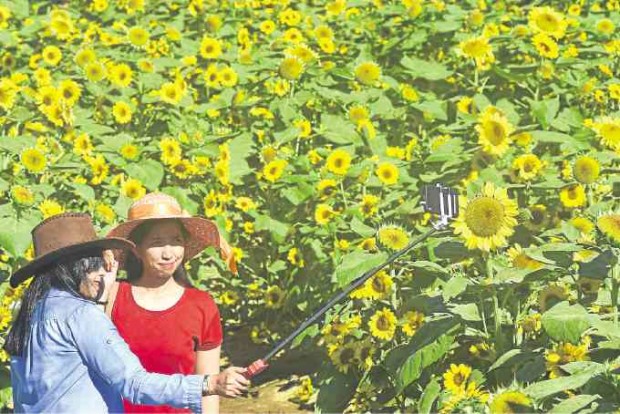The many uses of sunflowers
SCIENCE CITY OF MUÑOZ—Beneath their bright yellow florets lies the real value of sunflowers, according to scientists.
At a demo farm in Central Luzon State University (CLSU) here, hundreds of visitors and students view the sunflower field as bright background for selfies.
But CLSU said the plant’s true value was in its economic contribution. “High-quality edible oil” can be extracted from sunflowers, said Prof. Mario Agustin, leader of the sunflower culture at the farm.
Sunflower oil, he said, “[had] a pleasant flavor” and contained linoleic acid (also known as Omega-6 fatty acid essential for a healthy diet) and vitamins.
Sunflowers are also a good source of biodiesel, he added.
Article continues after this advertisementAfter oil has been extracted, the sunflower meal can be processed into flour, or as a major source of protein in preparation of feed for livestock and poultry, Agustin said. The leaves can be used as forage for animals, he added.
Article continues after this advertisementThe seeds can be processed into snack food, like those of watermelon or “butong pakwan.”
Moreover. sunflowers are good sources of fiber for paper production, Agustin said.
Byproducts can be used to make organic fertilizers.
Raw sunflower seed is sold in farm stores at P50-P60 a kilogram, for bird feed and as conditioner for gamecocks.
Sunflower tech
In the early 1970s, the CLSU Research and Development Center started the research project aimed at developing a package of technology for the culture and production of sunflower suited for Philippine conditions. The National Science and Development Board (now the Department of Science and Technology) supported the project.
“We eventually scored a breakthrough in sunflower research and development,” said Agustin, who became the study leader in 1977.
Among the significant achievements were the development of three promising lines of sunflower, one of which could be grown for its oil.
Healthy oil
The project also developed technology that can be applied on different potential sunflower growing areas, invented a medium-scale sunflower seed thresher, and devised a processing technology for cracked seeds for use in cottage industries.
It enhanced awareness among Filipinos about the health and nutrition benefits of sunflower oil.
Farmers in Nueva Ecija province engaged in sunflower culture and production using the technology and seeds produced by CLSU, but over time, they lost interest, Agustin said. For many years, he said, sunflower farming was a forgotten enterprise.
Seeds from 2,000 seedlings planted were retrieved as a “showcase during the summer months,” Agustin said.
The average yield is 2,000 kilograms of seeds per hectare. It takes 110 days for the plant to reach maturity.
“A net income of at least P45,000 a hectare can be realized in 110 days of sunflower seed production. Double that amount if the seeds are processed into snack,” Agustin said.
